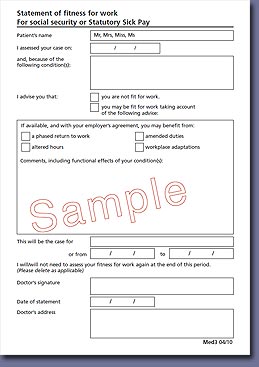From 6 April this year, GPs will be required to issue those suffering from ill health with fit notes rather than sick notes, following the introduction of new regulations that aim to support more people with health conditions to return to work.
However, doctors will not have to determine whether patients are ‘100-per-cent fit for work’, as originally proposed, but instead declare that they are ‘not fit for work’, or ‘may be fit for some work’.
 In its response to the consultation on the Social Security (Medical Evidence) and the Statutory Sick Pay (Medical Evidence) (Amendment) Regulations 2010, issued on 29 January, the Government said the new system is in the interests of individuals, their employers and the health-care professionals treating them, and should lead to subsequent savings to the NHS and a reduction in long-term sickness absence.
In its response to the consultation on the Social Security (Medical Evidence) and the Statutory Sick Pay (Medical Evidence) (Amendment) Regulations 2010, issued on 29 January, the Government said the new system is in the interests of individuals, their employers and the health-care professionals treating them, and should lead to subsequent savings to the NHS and a reduction in long-term sickness absence.
Those who took part in the consultation, including employer bodies, unions, the medical profession, and other stakeholder organisations, were broadly supportive of the move to the fit-note system, which was originally proposed by Dame Carol Black in her review of the health of the working-age population.
Although there was no consensus among respondents on dropping the ‘fully’ fit for work option, the Government decided to remove it in favour of the other two aforementioned options, as this would “best meet the policy’s objective to empower individuals to make their own positive decisions to return to work and potentially reduce unnecessary appointments for doctors”.
The ‘may be fit for some work’ option has been amended to include ‘taking account of the following advice’. This acknowledges that it is not the doctor, but the employer, in consultation with their employee, who is best-placed to make the decision as to whether they can accommodate any changes to facilitate a return to work.
The Government based this decision on its belief that “doctors completing the medical statements do not have the knowledge or expertise about an individual’s job role and the risks involved”. It concluded that they do not need to have such knowledge, or any special occupational-health expertise, as suggestions made by them “will be based on the patient’s health condition and not job-specific”.
The TUC disagreed, however, with general secretary Brendan Barber warning that “the new notes will only help ill or injured workers get back to their jobs more quickly if GPs are better trained in how to recognise occupational diseases, and if they know what a patient’s job entails”.
He went on: “Simply handing a list of tasks an individual can do to their employer won’t help that worker get better, or get back to their full fitness. No one should be forced back to work before they are able, especially as their work may have been what made them ill in the first place.”
But the Government was adamant in its response that, in all cases, “it is the employer’s responsibility to carry out a risk assessment when an employee returns to work to ensure there is minimal risk to them and others in the workplace”.
Risk consultancy Healthcare RM welcomed the removal of the ‘100-per-cent fit’ option as “a move in the right direction”. Added chief executive, Pamela Gellatly: “GPs have neither the experience nor the time to make proper assessments and are largely reliant on the subjective reporting of the individual about what their job involves. Placing more responsibility on both the employer and the employee to work together to find appropriate solutions should have a positive impact on reducing the numbers of days lost to sickness absence each year.”
Partner at law firm Eversheds, Simon Rice-Birchall, said the new system should focus employers’ attention on how they manage sickness absence: “Those who fail to engage with the new approach could find themselves at increased risk of disability discrimination claims. This is because a new-style report might highlight changes that an employer could make to the employee’s duties or workplace that would help them return to work sooner.”
Source: SHP

